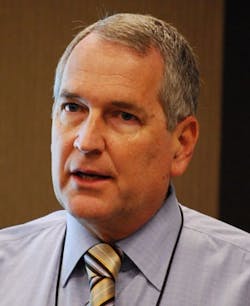Check out ControlGlobal.com on Google+
Tunable diode laser (TDL) analysis holds the potential to reduce emissions and provide more agile control of combustion processes across industry. To see if they can fill the bill in terms of accuracy, operability and reliability in coal-fired power plant applications, a joint effort is underway by the Electric Power Research Institute (EPRI) and Yokogawa.As with any new technology, there are many technical obstacles to overcome, said Richard Himes, EPRI senior project manager in his presentation at this week's Yokogawa User Group meeting in New Orleans. The key challenge with the in situ measurement of flue gases with TDL is making sure that the laser makes it across ducts—in a range of operating conditions—so the spectroscopy data can be evaluated, Himes said.
EPRI uses a three-part process to examine new technologies, which includes lab testing and assessment, single-path field demonstrations and cost-benefit analyses. To evaluate TDL monitors for flue-gas monitoring, Himes reports that EPRI and Yokogawa set up a one-meter sample cell testing system at the University of California Riverside to measure moisture and gas concentrations over a range of temperatures and pressures.
Gas Analysis Key to Optimization
"Ideally, coal-fired plant operators want to get paired-species measurements of gases, such as NOx and CO, which can show their relationship," explained Himes.
"This is important because there's an operational tradeoff between NOx and CO emissions. For example, operators will limit excess oxygen to minimize NOx emissions, but CO emissions can then increase exponentially if there is too little excess oxygen. So users want to find the optimal zone before CO spikes."
It is precisely this ability to measure multiple gas concentrations simultaneously and in situ, without the time delays or maintenance-intensive sample conditioning, that holds so much promise for TDL analysis. Himes added there's significant market potential for TDL and quantum cascade laser measurements in coal-fired electric utility operations—both for process control of O2, CO, NH3, SO3 and for compliance measurements of HCl and SO3.
"Line-of-sight measurements have potential for improved representation in large-scale ducts," said Himes. "The challenge in zero/span procedures is making sure they're acceptable to the U.S. EPA for compliance measurements. TDL is still a relatively new technology that needs to prove accuracy over typical process application conditions, as well as its operability and reliability characteristics."








